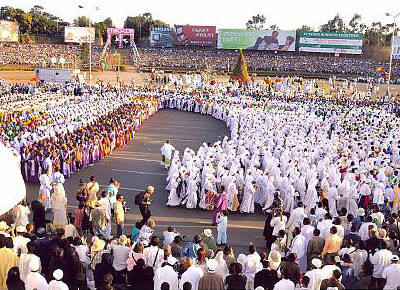Erbore are a very exciting people. Their happy way of life is rooted in their deep belief that their singing and dancing eliminates negative energy and with the negative energy gone, the tribe will prosper. Although relatively large, Erbore is far more rustic and unaffected than many similarly sized towns in South Omo. The Erbore build their huts slightly oval in shape. The Erbore have a bodily mutilation of raised dots
The Hamer is a tribal people in southwestern Ethiopia. They live in Hamer Bena woreda (or district), a fertile part of the Omo River valley, in the Debub Omo Zone of the Southern Nations, Nationalities, and Peoples Region (SNNPR). They are largely pastoralists, so their culture places a high value on cattle. The Hammer people are semi nomadic pastoralists migrating every few months to find pastures for their goats and
The Karo or Kara is a small, endangered omotic tribe with an estimated population between 1,000 and 3,000. They live along the east banks of the Omo River in southern Ethiopia and practice flood retreat cultivation. The crops that are grown by them are sorghum, maize and beans. Only small cattle are kept because of the tsetse flies. These flies are large and consume the blood of vertebrate animals. Like
Konso, named after the Konso people, is known for its religious traditions, waga sculptures, and nearby fossil beds (the latter an archaeological site of early hominids). The site was added to the UNESCO World Heritage List on September 30, 1997 due to its purported universal cultural significance of terracing agricultural practice. The Konso live in an isolated region of the basalt hills. The area is made up of hard rocky
TribeThe Mursi are a nomadic cattle herder ethnic group located in the Debub Omo Zone of the Southern Nations, Nationalities, and People’s Region in Ethiopia, close to the Sudanese border. According to the 2007 national census, there number is estimated 7,500. The Mursi people are the most popular in Ethiopia’s Omo Valley. They are well known for their unique lip plates. They are settled around the Omo River and
Suri or Surma TribeSuri, also known as the Surma people live in the southwestern plains of Ethiopia. They raise cattle and farm when the land is fertile. Cattle are important to the Suri, giving them status. The more cattle a tribesman has, the wealthier they are. In order for a man to marry a woman in the Suri tribe, he must own at least 60 cattle. Cattle are given to
Tsemay TribeAlso spelled Tsamai, they are found living in the semi-arid region of the Omo Valley. These people are agro-pastoralist and use both livestock herding and agriculture to survive. Common crops grown by the tribe are sorghum, millet and of course cotton plantation by irrigating the Weyto River. Like the Hamer tribe, the Tsemay boys have to successfully complete a bull jumping event. This is a ceremony where the boy
Addis Ababa was founded in 1886 by Emperor Menelik II who moved his capital city from Ankober (a town 175 km. to the northeast) to the top of the Entoto Mountains. Addis Ababa – the “new flower”, was later set at the foot of the Entoto Mountains. It is centrally located within Ethiopia as a capital city. The altitude of Addis varies from 3200m at the top of Entoto to
The modern town of Axum does not easily show the evidence of the splendors of its glorious past. Nevertheless, the historic footprints are represented by extensive traces of noble buildings with large stone foundations, side by side with the ruins of even more impressive structures such as: temples, fortresses, and rich palaces. The hand of nature in the form of heavy downpours of rain, seems to take the place of
Founded during the first decades of the 20th century at the southern tip of Lake Tana and along the banks of the Blue Nile, Bahir Dar has gone on to become the foremost tourist destination of north western Ethiopia. The city has an altitude of 1,830m above sea level and a tropical climate with an average temperature of 190c. At Bahir Dar you can spend days strolling along palm-lined avenues,

